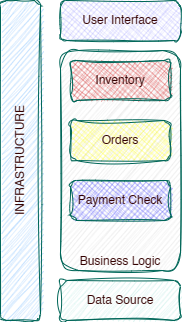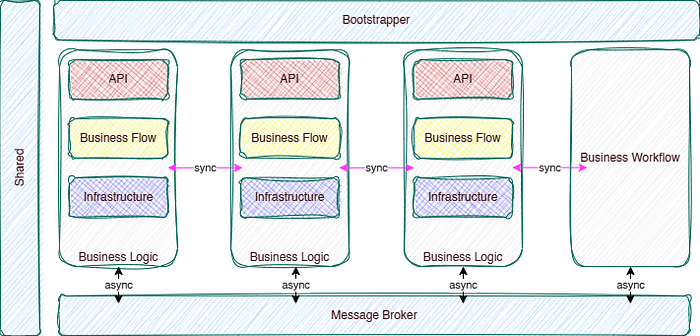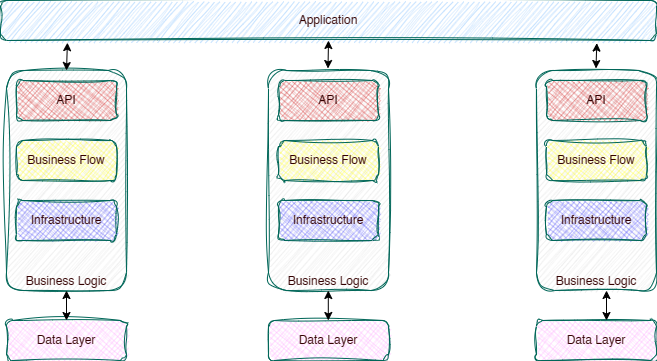Closer Look at Microservices vs Modular Monolith vs Monolith: Exploring the Pros and Cons
Think a place where software development is agile, scalable, and flexible. That’s the promise of microservices, a modern architectural approach to challenging the long-standing monolithic way.

A monolith application is more like a one-piece software. Everything happens on the same project, same code base.
Different is Modular Monolith was it’s still a monolith application, but in pieces. Modules in this approach are separated logically, not physically. If we want to physically separate it, we have to implement the microservice approach.
A microservices application is collection of a lot of small applications. Everything happens individually on different code base.
Actually on that versus, there no actual winner.
In some cases monolith can easily dominate microservices or vice-versa. On that article we will deep dive to these pros and cons, and use-cases.
Buckle up for Zero to Hero: Microservices vs Monolith architecture.
Monolith Approrach

Monolith applications are often simple applications. All the magic happens in the same place like one big advanced, confusing machine. Everything related your project (User I/O, Database process, business workflow, etc.) happens on the same place.
Like a life, this is also double edged sword. We have a lot of cons with Monolith, also has a lot of negative impact to our project. Let’s check one by one;
Why Monolith better?
If you’re just started the development and trying to figure out something on your local; Monolith will be best for you. Since all the magic happens in the same place you can debug the error easily and fix the issue. Even in big enterprise-scaled projects monolith still have a place during development.
- Easy Debug: Since all the magic happens in the same place you can check and test all the workflow to find the debug, after that you can fix. Since you have all the application you can test if it broke or not some other parts in the application.
- Developer-Friendly: More simply and clear code base in your project and reducing the complexity of distributed systems. You can work more efficiently as they have a all the view of the application, enabling easy debug steps, refactoring, and add improvements.
- Simplicity: The entire application is built as a monolithic. It means, it’s easier to develop, deploy, and maintain. Developers can focus on writing code without worrying about internal communication issues, network related issues (timeout-latency, serialize, etc.).
- Performance: Monolithic apps are extremely fast because of their simplicity. In Monolith app, functions, data access, DB operations, etc. are direct, without overhead of inter-process communications or network requests. Thanks to that, we have faster response times and better resource utilization, especially in workflows with heavy workloads.
Code base Management: In monolithic architecture, managing the code base becomes more streamlined. Since all the code is stored in a single repository, version control, code reviews, and collaboration among developers are simplified.
Disadvantage of Monolith?
If there is a lot of plusses in Monolith, why we’re not using in every project?
Like ying-yang, everything has a plus and cons, even in development.
Monolith can be perfect choice for some applications or business plans, but still have disadvantages.
Not Scalability : Monolithic architectures can face challenges when it comes to scaling. As the application grows in size and complexity, it becomes harder to scale specific components independently. Scaling the entire monolith can result in inefficient resource utilization and can be costly, especially if certain components have higher resource requirements compared to others. This lack of granular scalability can limit the ability to handle high traffic or accommodate evolving needs.
Limited Flexibility: Monolithic architectures often trust on a single technology stack or framework on the application. This can block the ability to adopt new technologies, languages, or frameworks that might be better suited for certain functionalities or development needs.
One Fault to All: In a monolithic architecture, a failure in one component can potentially impact the entire application. Since all components share the same infrastustructure, a bug or crash in one flow can lead to the entire application becoming unavailable.
Last Words about Monolith
While monolithic architectures have disadvantages, they have been successfully used in certain applications, particularly when the scale and complexity are manageable and not changable later.
Modular Monolith Approach
New cheriff in town.

A 𝐌𝐨𝐝𝐮𝐥𝐚𝐫 𝐌𝐨𝐧𝐨𝐥𝐢𝐭𝐡 𝐚𝐫𝐜𝐡𝐢𝐭𝐞𝐜𝐭𝐮𝐫𝐞 is similar to a Monolith; but more flexible way.
In this approach, instead of one monolith app, we can tear it down to more manageable, dedicated modules. These modules are still coupled, it’s not flexible as microservices but still can be deployed and developed independently.
In modular monolith, logic encapsulation enables high reusability, while data remains consistent and communication patterns simple.
It is more easy to develop or maintain a modular monolith. With microservices you have hundreds of microservives in different machines, regions, etc. and this creates infra complexity and increase operational costs (both financial and workload)
Services in Modular Monolith can work with async (black arrows) with the Message Broker. Or also can work with sync (purple arrows) without Message Broker, if needed.
Good parts of Modular Monolith
Modular/Independent Development: modular monolith allows developers to organize the codebase into separate modules or workflows. Development team can work on modules independently, and this can leads to shorten deployment times.
Better Reusability: Modules in a modular monolith can be reused. Multiple modules might share common features or libraries, eliminating duplicative code and fostering code reuse. This increases consistency, decreases the risk of defects, and improves development efficiency.
Smooth Migration: If required, a modular monolith can be migrated with the Microservices with very little workload. The monolith can be divided into loosely linked modules, making it simpler to pinpoint potential microservice borders in the future. With this strategy, a smoother migration path is possible.
About the disadvantages;
The modular monolith approach is sharing the same disadvantages with Monolith approach.
Microservices

Microservices (a.k.a the microservice architecture) is an architectural style that structures an application as a collection of services.
Thanks to that we have a lot of advantages, a few advangates are;
- Independently deployable: In microservices we don’t have any requirement for deployment. We can deploy these services any place, Since services communication in API mostly, there is no need to host them on the same Infrastructure.
- Loosely coupled: Microservices are developed independently, thanks to that codebase is loosely coupled, because of that refactoring or updating/changing the framework is very easy.
- Scalability and Elasticity: Since microservices are independent and loosely couple, we can deploy and scale as musch as we needed, If there is a big load in X service, we can easyly deploy a second one and split the workload with various ways.
- Fault Isolation and Resilience: Unlike the Monolith, if one microservice is failed, it will not crash the entire application. With that we can secure our uptime and even delete the problematic service and install a new one in a blink of an eye.
One of the disadvantages of Microservices are is latency. since they are not hosted in same infra and distributed over the network, they are communicating with API’s mostly. During that communications, if our latency increases maybe some of the workloads will not work properly.
We have to make sure we tolerate these latencyies with async functions or even protect the workload with timeouts.
Also, microservices architecture should be planned well because of operational workload and Infra complexity.
All the services hosted in individual hosts and this may be overwhelming in big-scaled apps. Managing and coordinating multiple services, each with its own codebase, dependencies, and communication protocols, can be challenging.
Additionally, operational tasks such as monitoring, logging, and deployment become more complex in a distributed environment.
So, Who is the Winner?
Actually, there is no certain winner.
Choosing the right architecture depends on the specific requirements of the application, the scale of the project, the development team’s expertise, and the need for future scalability and flexibility.
Each architecture has its pros and cons, and a careful evaluation of the project’s needs and trade-offs is essential to make an informed decision.
Monolith
- Monolith is a traditional software architecture where the entire application is built as a single, cohesive unit.
Advantages:
- Simplicity in development and deployment, better performance due to direct function calls, no network latency, and ease of scaling the entire application.
Disadvantages:
- Limited scalability and technological flexibility, challenges in fault isolation, errors can crash entire application and longer development cycles for changes or updates.
Modular Monolith
- Modular Monolith is a hybrid approach that combines some benefits of both monolithic and microservices architectures.
Advantages:
- Offers modularity and independent development like microservices while still residing within a single codebase for simpler deployment and management.
Disadvantages:
- Limited scalability compared to fully distributed microservices, challenges in dependency management, and potential trade-offs between monolithic and microservices characteristics.
Microservices
- Microservices is an architectural style where an application is divided into a collection of small, independent services that communicate with each other over a network.
Advantages:
- Scalability and elasticity through independent scaling, fault isolation for better resilience, and independent development and deployment for faster iterations.
Disadvantages:
- Increased complexity and operational overhead, challenges in inter-service communication and data consistency, and potential difficulties in managing a distributed system.
